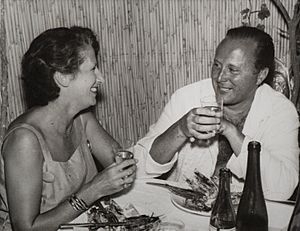Francis Gerald William Knowles facts for kids
Sir Francis Gerald William Knowles, 6th baronet (born March 9, 1915 – died July 13, 1974) was an amazing British scientist. He studied biology and animals, and was a Fellow of the Royal Society. He even became a professor at King's College London. People saw him as a brilliant scientist.
Contents
Early Life and Education
Francis Knowles was born in Ottawa, Canada. His father, Francis Howe Seymour Knowles, was also a scientist. He studied people's bodies and cultures. When Francis was young, his family moved back to England.
Francis went to school at Radley College and then to Oriel College, Oxford. He studied zoology, which is the study of animals. He finished his first degree in 1936. After that, he won a special scholarship. This allowed him to do research in Italy in 1937 and 1938. There, he started looking into how hormones make lampreys and crabs change color. He earned his MA and PhD degrees in 1939.
A Unique Scientific Career
After his research in Italy, Francis Knowles became a senior biology teacher. He taught at Marlborough College in England. While teaching, he wrote several biology books. Some of his books included Man and other Living Things and Biology and Man. He also wrote about keeping fish in aquariums.
Even as a teacher, he kept doing his own research. He studied how crustaceans (like crabs and shrimp) change color. He often worked during school holidays. He used these animals because they were easy to study. His students got to see real scientific research happening. This was very rare in schools back then.
Discovering Neurosecretion
Later, Francis became very interested in a new idea called neurosecretion. This is when special nerve cells release hormones into the blood. He quickly started using new tools to study this. He especially liked using the electron microscope. This microscope helps scientists see tiny things.
In 1958, something big happened for Francis. A famous professor, Sir Solly Zuckerman, was very impressed by Francis's work. Professor Zuckerman knew Francis from university. He asked Francis if he could do more research at Marlborough. When Francis said no, Professor Zuckerman helped him get a job. This job was at the University of Birmingham. It was unusual because Francis knew a lot about tiny animal parts, but not much about human bodies. But the university trusted Professor Zuckerman's advice. So, Francis left teaching to become a university scientist.
Research and Recognition
At Birmingham, Francis quickly became a very active scientist. He always wanted his experiments to be perfect. He started studying how hormones work in the brains of dogfish and monkeys. His ideas and how he shared them inspired many other scientists. His talks at science meetings were always clear and led to interesting discussions.
Francis was also good at organizing things. In 1962, he helped plan a big science meeting. It was about new ways to study hormones. His hard work led to him becoming a Reader in 1963. Then, in 1966, he was chosen as a Fellow of the Royal Society. This is a very high honor for scientists. In 1967, he became a full professor. That same year, he moved to the University of London. He became a professor of anatomy at King's College London.
At King's, Francis went back to studying fish. He also helped a lot with running the college. He was a great leader in meetings. He was part of several important science committees. He worked to help young scientists in Britain connect with scientists in other European countries.
In 1973, he organized a big international meeting in London. It was about neurosecretion. He was very happy about this meeting. It was 20 years after he first shared his work on crustaceans. He gave a speech looking back at "Twenty Years of Neuroscretion."
Francis Knowles died suddenly in 1974. He was only 59 years old. He was still working on a book about the meeting he organized. His friends and colleagues remembered him as a brilliant scientist. They also said he was a warm and exciting person who loved life.
Personal Life
In 1948, Francis married Ruth Jessie Brooke-Smith. They had one son, Charles Francis, and three daughters. In 1953, Francis became a baronet after his father passed away.
In 1955, he bought Avebury Manor. This was a beautiful old house near the famous Avebury stone circle. He loved restoring the house. He and Ruth often entertained guests there. Many people remembered his kindness and hospitality. His home at Avebury was a grand family house. It was also open to the public. Some of his friends thought he seemed like he belonged in the 1700s. Others said he showed that you could be a great scholar and a warm person at the same time.
Francis Knowles died in London on July 13, 1974. He is buried in the churchyard of St. James Avebury. This is next to the house he worked so hard to restore.
See also
- Knowles Baronets


